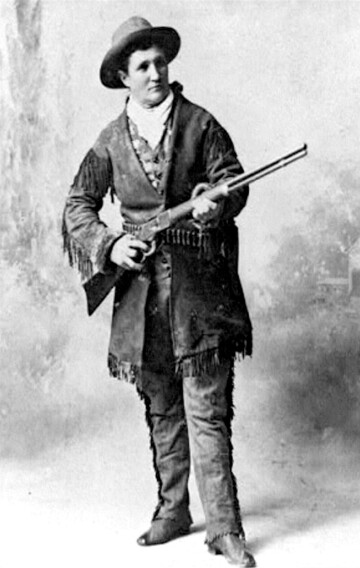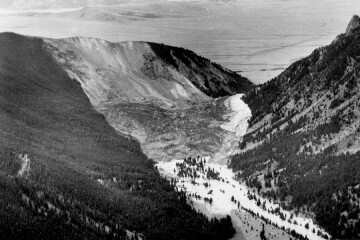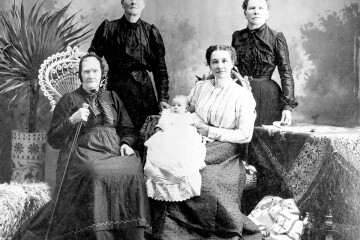Calamity Jane Dries Out in Bozeman
Livingston News - “Calamity Jane is in town again. She entered a certain newspaper office in this city this morning and wanted to know where the dirty cur was who said she was in the poor house. She wanted it clearly understood that…she would cut any low-lived son of brute into shoe strings who said she was ever dependent on charity for a living.” (to be continued) – Butte Daily Inter Mountain, February 28, 1901.
Most people who are familiar with Calamity Jane will recognize the above quote as consistent with her tough, fighting image. However, the “poor house” incident Calamity refers to piques one’s curiosity. In the late 19th and early 20th centuries, “poor houses” or “poor farms” referred to places that could care for those who could not care for themselves. Often, poor farm residents were experiencing financial difficulties, but some were ill, orphaned, or had no other place to go, and their stay was temporary. What happened to Calamity, and where? It is clear from the article that Calamity Jane adamantly denied ever accepting charity from a “poor house,” but what was the full story?
Few details of Calamity Jane’s early life are known. She was born Martha Canary (or Cannary) in the mid-1800s in Missouri. At a young age her family moved west to Montana Territory, where she was soon left to fend for herself. She likely picked up the nickname “Calamity Jane” prior to her residence in the Black Hills during the gold rush in the 1870s. Long before the mysterious 1901 poor house episode described above, Calamity Jane’s exploits and adventures throughout the West had elevated her to celebrity status. However, she did not necessarily always endear herself to the local authorities, and Calamity Jane’s heavy drinking often got her into trouble.

During the winter of 1901, Calamity Jane was roaming Montana, searching for work. On January 8, The Billings Gazette reported that, “according to the Yellowstone Journal,” she was in Miles City, attempting to find a job as a cook. The article also mentioned (or perhaps warned) that if unsuccessful in her attempts to secure employment in Miles City, Calamity Jane next planned stops in Forsyth and Billings.
It appears she was unsuccessful at her job-hunt in Miles City. In late January, Calamity was involved in a dispute with a Billings hotel and restaurant proprietor named Yee Sam Lee. Calamity claimed that Lee refused to return her trunk, which held several hundred dollars’ worth of clothing and bedding. The Billings Gazette reported on January 29: “The trunk is said to contan [sic] only three dresses that would not bring very much at even a secondhand store.” One wonders why Mr. Lee bothered to keep Calamity Jane’s trunk if the contents were indeed so invaluable. This report suggests, along with the other newspaper accounts of her job-hunting, that Calamity was likely having some financial difficulties.
Despite her apparent lack of funds, Calamity Jane still managed to make headlines in every town she stopped. She surfaced in print again on Saturday, February 16. According to the article in Bozeman’s Avant Courier, the previous Friday (February 8), she had been traveling by train from Livingston to White Sulphur Springs, when she became suddenly ill. The article explained: “The authorities were notified by Agent Hoyt, and [he] met her at the depot. She was out of funds and consequently taken to the Poor Farm, where, under the treatment of county physician Safley and careful nursing of Mr. Holmes, she was discharged on Monday and went on her way rejoicing.”
Other newspapers note that Calamity Jane was taken to the poor farm in Gallatin County, rather than to one in Park County. This claim is further supported by the Bozeman individuals—Hoyt, Safely, and Holmes—who are mentioned in the Avant Courier article. According to Bozeman’s 1900-1901 Polk City Directory, Merrill L. Hoyt, or “Agent Hoyt” was a station agent for the Northern Pacific Railway. He lived on North Church Avenue in Bozeman, not far from the railroad depot on North Wallace Avenue. Dr. William Safley operated a medical practice on Main Street in Bozeman, and resided at 401 South Grand. Charles Holmes, according to his September 12, 1905 obituary in Bozeman’s Republican Courier newspaper, was a Swedish immigrant who served as the Supervisor at the Gallatin County Poor Farm for twenty years.
After her weekend in the Poor Farm, Calamity Jane was released to continue her journeying. Given her notoriety, it is not surprising that reports of Calamity’s misfortune spread across Montana: “‘Calamity Jane’…has again been heard from at Bozeman where she was taken sick and had to accept the aid of the county. Calamity seemed to be entirely without friends though after accepting the hospitality of the county until her health was restored she departed eastward.” – Fergus County Argus, February 27, 1901.
Even a month after she left the Poor Farm, news of her misfortune was reported as far away as Dupuyer, Montana (northwest of Great Falls): “Calamity Jane, a noted character of Western border life, a friend of Buffalo Bill and a participant in many of the early Indian campaigns, has been admit [sic] to the poorhouse in Gallatin county.”—The Dupuyer Acantha, March 14, 1901.
Calamity Jane was not pleased with the press. As she traveled from town to town, she harassed newspapermen, denying that she was ever in the Poor Farm and seeking vengeance for her wounded pride. Fergus County Argus reporters sympathized with their Park County newspaper colleagues on March 6, when they related an unfortunate encounter that occurred in the Livingston newspaper office. “Calamity Jane struck town on the war trail and demanded to know the author of the article describing her as an inmate of the Bozeman poor house…The boss liar was called to the front and after exercising considerable ingenuity Calamity was persuaded that the report did not originate in Livingston and was induced to leave without killing an editor or reducing the office to a smouldering [sic] mass of ruins.”
On March 22, the Butte Daily Inter Mountain quoted Billings reporters when they lamented: “Calamity’ has been making life a burden for those people who announced that she was a county charge.” Even The Dillon Tribune picked up on her wrath, reporting in a March 29 article titled, “She’s No Pauper,” that “She resents the newspaper stories about her being the inmate of a poor house and is making life miserable for the scribes.”
Bozeman’s Avant Courier newspaper printed the story on February 16 (the weekend after the event occurred), but Livingston reporters seemed to get the brunt of Calamity’s wrath. The Billings Gazette (March 19) believed a Livingston newspaperman was responsible for starting the firestorm. “The space writer in Livingston, who started the report of her being a county charge, narrowly missed annihilation and the bombardment he received from the tongue of ‘Calamity’ made him feel smaller than 30 cents.”
The publicity did spark at least one of Calamity Jane’s friends to step to her aid. Dr. David Franklin “White Beaver” Powell, friend of Buffalo Bill Cody, heard rumors at his home in Minnesota that Calamity was in trouble financially. Concerned, Dr. Powell inquired as to Calamity’s circumstances, and offered to provide help. The Billings Gazette printed his message on March 19: “There are many of us old-timers of peak and plain who will gladly join in making her life more comfortable if she is really in dire want…and now that she is helpless the cloak of charity should be thrown over the unfortunate part of her life. While I have not communicated with her foster brother and lifelong companion, Colonel Cody, I know positively that he will join in adding his contribution to her comfort, and there are many others who will do the same.”
A week later, the Butte Daily Inter Mountain printed an update, claiming that Calamity Jane had received sixty-five dollars from Dr. Powell. Sixty-five dollars in 1901 converts to roughly one-thousand, eight-hundred dollars in today’s currency—a considerable sum. It is difficult to verify whether she in fact received this money, or if she was gifted any additional funds from friends like Buffalo Bill Cody. Calamity Jane only lived a couple more years after her weekend experience at the Gallatin County Poor Farm. She died on August 1, 1903, in Terry, South Dakota. The cause of death was bowel inflammation (likely brought on by alcoholism) and she was buried a few days later in Deadwood, South Dakota.
As for that “certain newspaper office” in Livingston (see article introduction) that received the unexpected visit from Calamity Jane on February 28, 1901, it survived to print another day. “…She nearly scared the ‘prints’ out of a year’s growth by her wild and ferocious antics, and it required a nice, artistic job of lying to convince her that she was in the wrong place. She wandered out after a time, still vowing the direst kind of vengeance upon the man who wrote the article which said she was in the Gallatin county poor house. She left today for Bozeman.”




